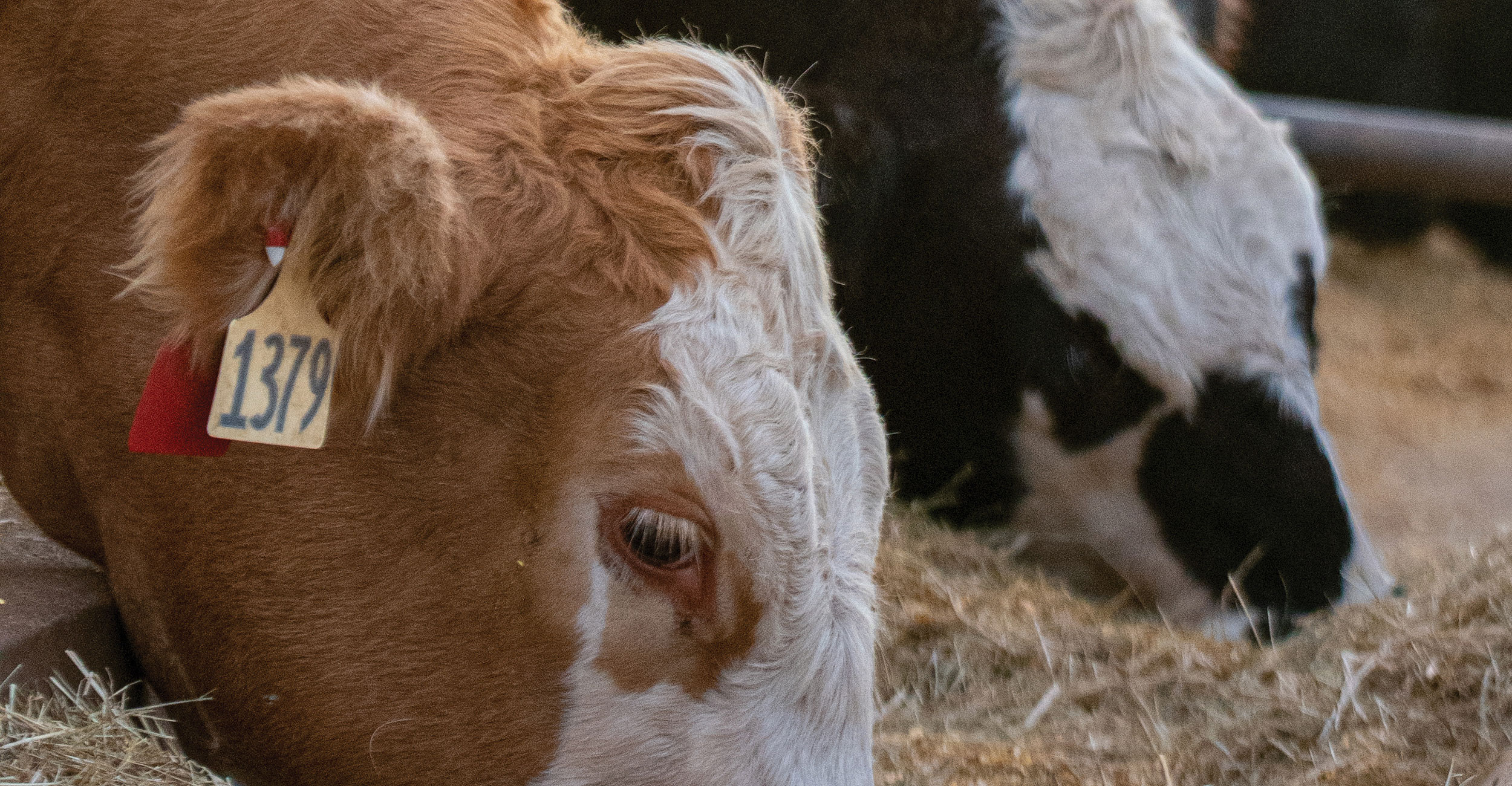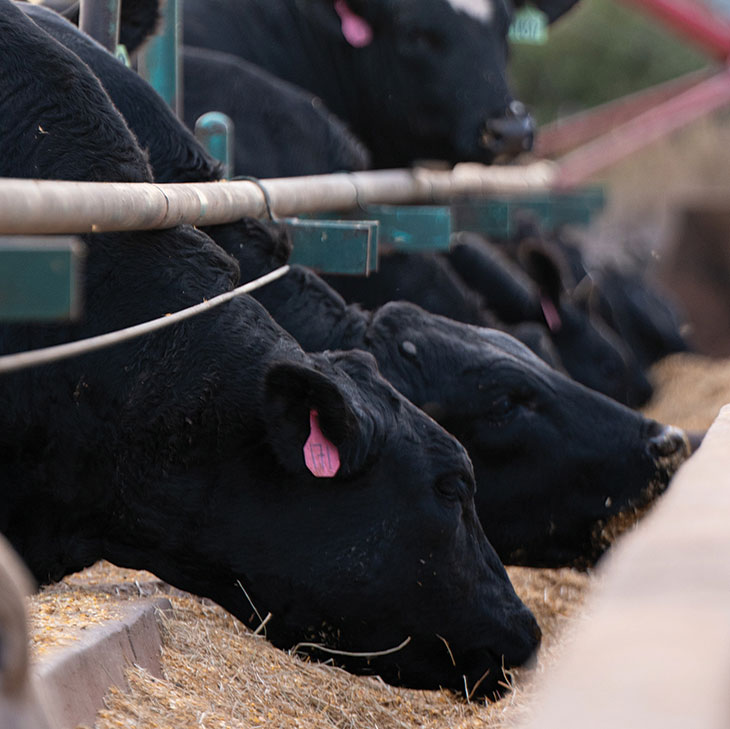
Crossing New Lines
Friday, December 17, 2021
Media Contact: Samantha Siler | Communications and Marketing Manager | 405-744-2977 | samantha.siler@okstate.edu
For decades, crossbreeding in beef cattle has resulted in hybrid vigor and more beef for consumers. But, what happens when you cross beef bulls with dairy cows?
In the spring of 2020, Oklahoma State University animal and food science researchers started a cattle genetics research project to see how offspring from this cross would fit in the production change, said Paul Beck, animal and food sciences associate professor and OSU Extension beef nutrition specialist.
The research took place at the Willard Sparks Beef Research Center, an OSU research facility used to conduct beef cattle research, teaching and extension programs.
Various dairies have crossed purebred dairy cows with purebred beef bulls to add value to the offspring, Beck said. OSU’s research is seeing if these hybrid cattle would be more cost effective for dairy farmers.
“We’re doing this research because we wanted to look at these half-blood beef by dairy crossbreds and see where they fit production wise,” Beck said.
Dairy cattle are known for meat quality and higher marbling, but not for heavy muscling, productivity or feed efficiency, Beck said. Beef cattle typically have higher muscling and growth but have less marbling in the meat, he added.
“Dairies breed their cattle to improve milking efficiency, whereas cow-calf operations breed to improve feed efficiency and carcass quality,” said Garrett Farran, research coordinator at the center.
Holsteins take longer to put on fat because they grow at a faster rate, Farran said.
“This creates a larger frame, which some rails at a packing plant are not tall enough to hold, bringing carcass discounts, and in some cases, rejection of that steer,” Farran said.
Breeding these two types of cattle can achieve greater profitability for the dairies and hybrid vigor for the calves, Beck said.
Hybrid vigor, or heterosis, comes from the mating of two different breeds within the same species so the offspring get the most beneficial genes from the two parents, Beck said.
Researchers discovered the new hybrid cattle carcasses contained more marbling than purebred beef cattle. The more marbling meat has, the juicier and more tender the meat cuts can be, said Blake Wilson, assistant professor of ruminant nutrition and Willard Sparks Beef Research Center faculty supervisor.

Among the four grade standards for beef — prime, choice, select and standard — prime is the highest quality grade. Grades are determined by marbling, or fat, in the meat. With the added marbling, the hybrids produce more prime or choice carcasses than usually produced with beef cattle, Beck said.
“When we add in the beef breeds’ muscling, performance and efficiency increases,” Beck said. “This is so these cattle could fit better into our beef production system and provide the benefits of higher quality marbling, more muscling than a dairy animal, and better gains and efficiency than a 100% dairy animal.”
Although meat from dairy cattle is typically of high quality, it looks different to consumers, making the meat less desirable from a retail standpoint, Wilson said.
“The main issue with Holsteins is that the yield is not there,” Wilson said. “They have a larger frame, but they have less muscle mass along that frame. The steak size and steak shape is less than ideal.”
The hybrid dairy/beef cattle have a high quality meat without having misshapen steaks, Wilson said.
This improvement will allow the hybrid the calves to be worth three to four times more than what the dairy producers would get from a purebred dairy animal, he added.
The dairy industry is mostly dependent on the heifers and cows because they produce the milk, Beck said. The only need for male dairy cattle is reproduction, Beck said.
The dairy industry wants to use the best genetics possible, but almost always uses artificial insemination, Wilson said, because dairy bulls are aggressive and expensive to feed.
“The top half of the cows will be bred to a Holstein bull, and those calves will be held back as replacements to improve milking genetics,” Farran said.
The purpose of this research is to help find a new source of revenue for dairy farmers, Beck said. The dairy industry uses sexed semen to yield mostly female calves, Beck said.
The dairy industry makes most of their profit from females but loses money on their purebred males, he added.
“The dairy industry has a lot of profitability issues because of the rising cost of feed and low value of the male calves they’re producing,” Beck said.
The researchers have used the lower quality genetic dairy cattle to produce these dairy/beef crossbred steers, Wilson said.
Breeding beef breeds, such as Angus or Limousin, to dairy breeds, such as Holstein and Jersey, results in offspring with different physical characteristics and collective genetics. This mating also creates hybrid vigor, Wilson said.
However, harvesting stages of the hybrid dairy/beef crossbreds have not come to normal stages of production.
Beef calves are put on pasture for about five months to raise them to 650 to 800 pounds, Beck said, and then they are fed grain for finishing.
“The dairy calves will leave the dairy at a day or two of age and go to a calf ranch where they are put on milk replacer and started on texturized mixed feeds,” Beck said.
At around 90 days old, the dairy/beef calves leave the calf ranch and are sent to the research facility weighing at 250 to 280 pounds.
Although these calves are at an extremely light weight, they go directly into a feedlot, Beck said.
“We’re realizing we can’t really manage them like a traditional dairy animal,” Wilson said. “We also can’t really manage them like a traditional beef animal. The genetics and carcasses are somewhere in between.
“We manage these calves more similar to a beef animal later in the feeding period and more similar to a dairy animal earlier in the feeding period.”
Researchers are in the early stages of this project, but overall, the OSU researchers have found the dairy/beef crossbred cattle are more profitable, Wilson said. They are still learning how these animals will fit into the U.S. system, he added.
This year, the U.S. Department of Agriculture’s annual report showed a decrease in licensed dairy operations. The hope is hybrid dairy/beef cattle will become popular for dairy farmers to bring more revenue, Beck said.
“Everyone is still trying to find out what that ideal management strategy is for the hybrid cattle because they are still fairly new,” Wilson said.
Story By: Juliann Hale | Cowboy Journal
